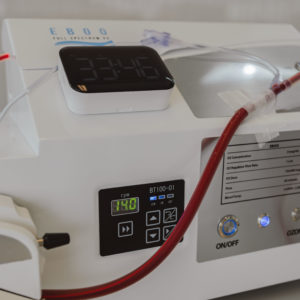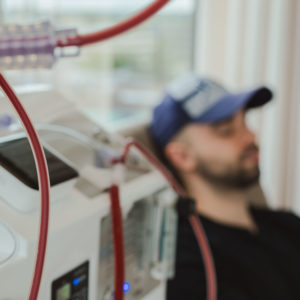4 min|Integrative
Symptoms of SIBO: When Good Bugs Go Bad
Wellness, Health, Gut HealthSIBO Spotlight
After years of assuming bacteria were dangerous, we now know the gut microbiome are essential for our health. We have trillions of bacteria in our bodies working with us to modulate our immune system, keep our brain healthy, and digest nutrients, in addition to many other functions.
However, our microbiome is a complex system, requiring checks and balances to ensure the right bacteria are in the right places in the body. Bacteria in the small intestine are kept at relatively low levels and well-proportioned, in terms of bacterial species, by a variety of factors:
- Acidic secretions from the stomach (1)
- Downward propulsive impulses (wave-like movements) known as the migrating muscle complex (MMC) (2)
- Secretion of bile from the gallbladder (3)
- Immunoglobulins in the small intestine, that fight bacteria and other pathogens (4)
- The ileocecal valve, a one-way valve connection between the small intestine and large intestine (5)
- Nervous system impulses (6)
If there are issues in one or many of these protective mechanisms, bacteria can overgrow in the small intestine. The result is small intestinal bacterial overgrowth (SIBO). Although bacteria can be beneficial to our health, an excess of bacteria, or bacteria located in the wrong area of our body, can create problems. The small intestine is an amazing organ - about 20 feet long, it is covered in tiny finger-like projections called villi that increase surface area, enabling efficient absorption of nutrients from food into the bloodstream.
An excess of bacteria decreases the small intestine's ability to absorb nutrients by:
- Competing for nutrients
- Producing compounds that inflame and irritate the small intestine, decreasing absorption of proteins, fats, and carbohydrates (7,8,9)
- Deconjugatation (disruption) of bile salts, leading to decreased fat absorption (8)
Without sufficient absorption of nutrients, we can experience a wide variety of symptoms as a result of SIBO. However, the most common concerns associated with SIBO are digestive symptoms. When large amounts of bacteria are present in the small intestine, these bacteria ferment carbohydrates found within certain foods, producing hydrogen (H2) gas in the process (10,11).
An abundance of archea, single-celled organisms similar to bacteria, produces an excess of methane (CH3) gas when they feed on large amounts of hydrogen gas (11). This increase in gas production can create severe bloating, as well as pain. Additionally, depending on the type of gas produced, common symptoms of SIBO include diarrhea or constipation (12). Excess methane gas is usually associated with constipation.
Excess hydrogen is associated with diarrhea. Additionally, it is possible to have an overgrowth of bacteria and archaea, resulting in irregular diarrhea and constipation. These symptoms are also typical of ‘irritable bowel syndrome’ (IBS). IBS is thought to affect roughly 11% of the population worldwide(13).
Research on the occurrence of SIBO in patients diagnosed with IBS shows 78% of IBS patients test positive for SIBO with a hydrogen breath test(14). It may be possible that those diagnosed with IBS actually have SIBO. This concept is strengthened by many cases of IBS patients experiencing an improvement of symptoms when treated for SIBO(15). The jury is still out, but for now, it would be advisable for patients with IBS to be tested for SIBO to at least rule-out this condition.
Signs and Symptoms of SIBO
Common Digestive Symptoms of SIBO (12,16)
- Chronic diarrhea or chronic constipation or alternating constipation and diarrhea
- Gas and bloating within one hour of eating
- Foul smelling gas
- Burping or reflux after meals
- Abdominal gurgling, discomfort, or pain
- Multiple food sensitivities
Commonly associated symptoms of SIBO
- Signs of B12 deficiency - fatigue, nerve issues such as numbness or tingling, depression, poor memory, megaloblastic anemia
- Signs of Vitamin A deficiency - night blindness, low immune system
- Signs of Vitamin D deficiency - poor bone health, hormonal imbalance, poor immunitySigns of Vitamin E deficiency - muscle weakness, poor immunity
- Signs of Iron deficiency - fatigue, shortness of breath, pale skin
- Psychiatric - stress, brain fog, poor memory, anxiety, depression (17)
- Skin - acne, rosacea, eczema, psoriasis, dermatitis (18,19)
- Other - joint pain, weight gain or weight loss, sugar and carbohydrate cravings
- Chronic illness - Crohns, Celiac, fibromyalgia, chronic fatigue syndrome, hypothyroidism (20, 21, 22, 23, 24)
- And many more...
SIBO is caused by a variety of factors, and in turn, can cause various symptoms and play a role in many disease processes. Since the symptoms of SIBO are similar to a variety of other gut conditions, it is impossible to diagnose based only on symptoms. Diagnosis is based on SIBO-specific testing.
Are you looking for support with improving your health and longevity?
Book a consultation with one of our experienced Naturopathic Doctors today!
References
- https://www.ncbi.nlm.nih.gov/pubmed/12870767
- https://www.ncbi.nlm.nih.gov/pubmed/22450306
- https://www.ncbi.nlm.nih.gov/pubmed/23333527
- http://onlinelibrary.wiley.com/doi/10.1111/imm.12474/full
- https://www.ncbi.nlm.nih.gov/pmc/articles/PMC3520169/
- https://www.ncbi.nlm.nih.gov/pubmed/7728404/
- http://www.gastrojournal.org/article/0016-5085(81)90012-3/abstract
- https://www.ncbi.nlm.nih.gov/pubmed/9840121
- https://www.ncbi.nlm.nih.gov/pmc/articles/PMC372488/
- https://www.ncbi.nlm.nih.gov/pubmed/20572300/
- https://www.ncbi.nlm.nih.gov/pubmed/12645795/
- http://pubmedcentralcanada.ca/pmcc/articles/PMC3099351/
- https://www.ncbi.nlm.nih.gov/pmc/articles/PMC3921083/
- https://www.nature.com/articles/ajg20001600
- https://www.ncbi.nlm.nih.gov/pubmed/17520365
- https://sites.ualberta.ca/~loewen/Medicine/GIM%20Residents%20Core%20Reading/MALNUTRITION/%20MALABSORBTION,%20ABSORBN%20TESTS/bacterial%20overgrowth.pdf
- http://onlinelibrary.wiley.com/doi/10.1111/j.1742-1241.2008.01763.x/abstract
- https://www.ncbi.nlm.nih.gov/pubmed/18456568
- https://gutpathogens.biomedcentral.com/articles/10.1186/1757-4749-3-1
- https://link.springer.com/article/10.1186/1471-230X-9-61
- https://www.nature.com/articles/ajg2003199
- http://ard.bmj.com/content/63/4/450.short
- https://academic.oup.com/jcem/article/92/11/4180/2598186
Related Articles

4 min|Dr. Alex Chan
EBOO for Chronic Inflammation: A Natural Approach for Systemic Relief
Regenerative Medicine, EBOO Therapy
4 min|Dr. Alex Chan
EBOO Therapy for Autoimmune Conditions: Exploring the Potential Benefits
Autoimmune Disease, Regenerative Medicine, EBOO Therapy


